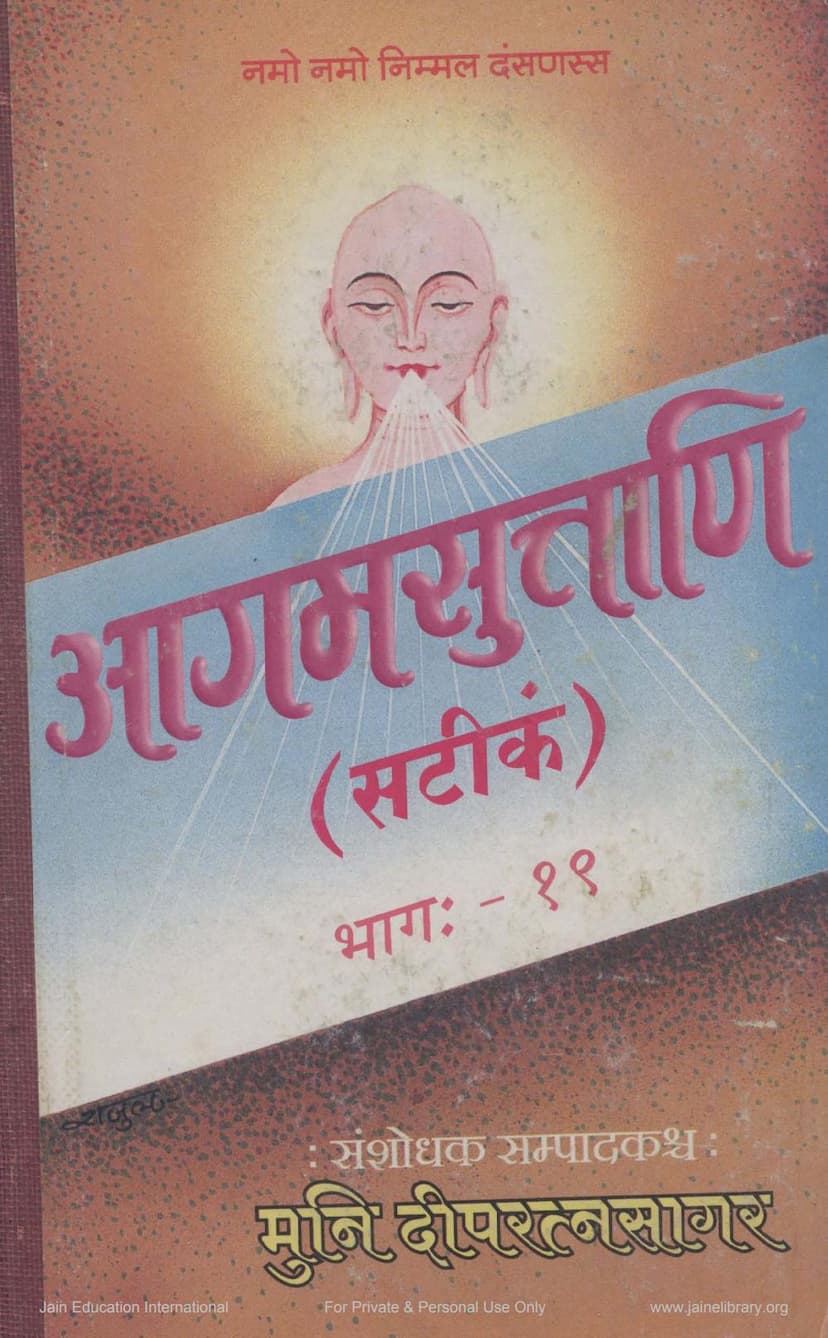Agam Suttani Satikam Part 19 Bruhat Kalpa
Added to library: September 1, 2025

Summary
Here is a comprehensive summary of the provided Jain text, "Agam Suttani Satikam Part 19 Bruhat Kalpa," authored by Dipratnasagar and Deepratnasagar, published by Agam Shrut Prakashan:
Overall Focus:
This volume, the 19th part of the "Agam Suttani" series, presents the Brihat Kalpa Sūtra (also known as Brihat Kalpa Cheda Sūtra) along with its commentary. The text delves into the intricate rules and regulations governing the conduct of Jain monks (Nigrantha) and nuns (Nigranthi), particularly focusing on their monastic life, विहार (travel/movement), dwelling places (Upaashraya), and adherence to the vows. The volume covers specific sections of the Brihat Kalpa Sūtra, including portions of its second and third chapters.
Key Themes and Contents:
The Brihat Kalpa Sūtra is a fundamental text in Jainism, detailing the code of conduct for ascetics. This part specifically addresses various aspects of their lives:
- Vihāra (Monastic Conduct and Travel): The text outlines rules for monks and nuns regarding their movement, especially during different seasons and in various types of terrains. It discusses the permissible duration of stay in specific locations.
- Upaashraya (Dwelling Places): Detailed guidelines are provided on the selection and use of dwelling places. This includes rules about the location, structure, and suitability of a dwelling for monks and nuns, considering factors like security, accessibility, and the presence of householders.
- Social Interaction and Etiquette: The text touches upon appropriate conduct when interacting with householders and the community, emphasizing the need for discretion and maintaining the sanctity of their vows.
- Prohibitions and Permissible Actions: A significant portion of the text is dedicated to detailing what is forbidden (No Kalpa) and what is permissible (Kalpa) for ascetics in various situations. This includes rules regarding:
- Living arrangements: Restrictions on residing in certain types of houses or areas, especially those that are exposed or compromised.
- Possessions (Upadhi): Guidelines on the types of items monks and nuns can possess and how they should be managed.
- Food and Drink: The text likely elaborates on rules related to the consumption of food and water, including restrictions on where and when it can be taken.
- Conduct in Specific Locations: Rules governing behavior in areas like marketplaces, crossroads, public squares, and near wells or water bodies.
- Specific Circumstances: The text addresses situations like illness, the need for alms (Bhiksha), and interactions with potentially troublesome individuals.
- The Role of the Ganadhara: The text highlights the responsibilities of the Ganadhara (chief disciple of an Ācārya) in managing the monastic community and ensuring adherence to the rules.
- Comparison of Gachha and Jinakalpa: The text engages in a discussion comparing the merits and characteristics of the 'Gachha' (a monastic order or tradition) and 'Jinakalpa' (the path followed by Jinas, implying a higher standard of asceticism). It suggests that both are significant in their own ways for spiritual progress and propagation of Jain teachings.
- Detailed Analysis of Rules: The commentary (Vritti) and the glosses (Bhāṣya) by various Ācāryas provide in-depth explanations of the sutras, discussing the underlying reasons for the rules and offering clarifications on intricate points. This includes detailed explanations of terms like 'Vagada' (enclosure), 'Dwara' (door/entrance), 'Vichāra Bhūmi' (places for reflection/activities), and 'Vāraka' (a container for water/alms).
- Specific Chapters Covered: The volume explicitly mentions covering sections like Uddeshaka 1, 2, and 3 of the Brihat Kalpa Sūtra, with specific references to 'mūla' (root text) numbers like 8-50, 8-96, etc.
Commentary and Authorship:
- Author: Muni Deepratnasagar (also referred to as Deepratnasagar) is credited as the researcher and editor.
- Publisher: Agam Shrut Prakashan.
- Commentary: The text includes the original sutras (Mūla) along with the Bhāṣya by Sanghadasgani, and the Vritti (commentary) by Ācāryas Malayagiri and Kṣemakīrti. This multi-layered commentary is crucial for understanding the depth and nuances of the Brihat Kalpa Sūtra.
Key Takeaways:
The Brihat Kalpa Sūtra, as presented in this volume, is a meticulous and comprehensive guide to ascetic discipline. It emphasizes:
- Strict adherence to rules: The text stresses the importance of following prescribed conduct to maintain the purity of the vows and the monastic order.
- Prevention of downfall: Many rules are designed to prevent situations that could lead to transgression of vows (Avinaya) or bring disrepute to the monastic tradition.
- Mindfulness and Awareness: The detailed regulations underscore the need for constant mindfulness and awareness in every action and situation for the ascetics.
- Theological and Philosophical Depth: The commentary provides insights into the philosophical underpinnings of these rules, connecting them to the core principles of Jainism like non-violence (Ahimsa), truthfulness (Satya), and asceticism (Tapas).
This volume serves as an essential resource for scholars, monks, nuns, and serious Jain followers interested in the detailed practical aspects of the Jain ascetic path as prescribed by the ancient Agamas.